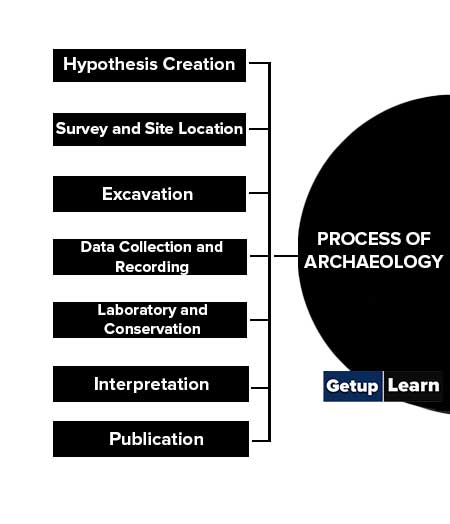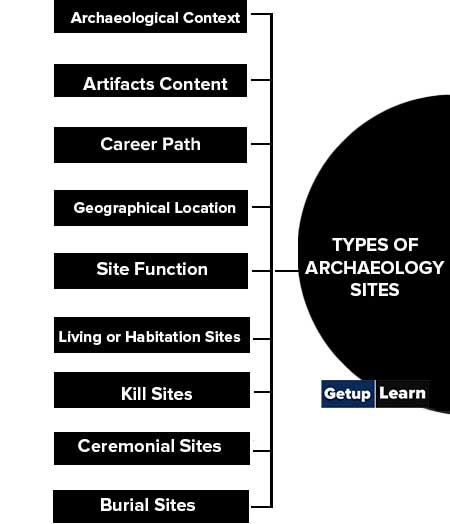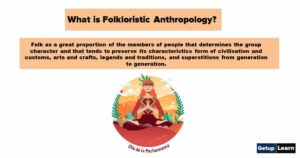Table of Contents
What is archaeology?
Archaeology is the study of the human past and human culture through material remains. It is a part of anthropology, which study of all human culture. From the million-year-old fossilized human remains to 20th-century buildings, archaeology analyzes the physical remains of the past to understand human culture.

Table of Contents
Artifacts, faunal remains, and human-altered landscapes are evidence of the cultural and material lives of past societies.
The word “Archaeology” is made with two Greek words- “arkhaios” which means ancient and “logos” which means study. So archaeology is the study of human activity in the past. In America, it is considered as a branch of anthropology while in Europe it has developed as an independent discipline.
What is Archaeological Anthropology?
Archaeological Anthropology is the study of sociocultural behaviour in the protohistoric and pre-historic past. The archaeologist deals with such remains from the past societies such as tools, shelters, remains of plants and animals eaten as food, and other objects that have survived. These remains are termed artefacts and are used to reconstruct past behaviour.
At the same time evolution of prehistoric culture with respect to the biological evolution of early human beings are studied. In other words, it is an anthropology of the past.
There are four subfields in anthropology: Archaeological Anthropology, Biological anthropology, Socio-Cultural Anthropology, and Linguistic anthropology. With the help of archaeological anthropology, archaeologists examine the material remains of past human societies to understand past human behaviour and cultural practices.
Both anthropology and archaeology are connected with human beings, whether in the past or the present. In the past time, there are so many human and animal bones are found in the excavations. Anthropologists are always associated with the archaeological excavations to study the human bones understanding age, sex, nature of death and much other information.
For example, an examination of the teeth at Mahurjhari, India has revealed the smoking habit of the people there some 2500 years ago.
Process of Archaeology
Archaeology uses scientific principles to guide its practices. Before beginning to excavate, an archaeologist needs a reason to dig, an excavation plan, and permission from the government of the place being excavated.
These are some of the process of archaeology projects:
- Hypothesis Creation
- Survey and Site Location
- Excavation
- Data Collection and Recording
- Laboratory and Conservation
- Interpretation
- Publication

Hypothesis Creation
Archaeologists do not dig randomly in search of artefacts. Excavations are conducted to answer specific questions or resolve particular issues. The only exception is in cultural resource management, undertaken when sites are in danger of being destroyed.
Survey and Site Location
Once archaeologists have a reason to dig, then they must identify where to dig. Sometimes, unexpectedly discovering evidence that a site existed in an area is the impetus to dig but even then the goal is not just to dig the site, but to answer questions about the people in their environment.
Evidence for sites can take many forms, including information provided in myths and stories, historical references, old maps, farmers’ reports of finds in their fields, satellite photographs showing patterns not visible from the ground, and the results of subsurface detection methods such as ground-penetrating radar.
The traditional surface survey often involves hours of walking over miles of terrain to find sites. Sites identified during the survey (usually by patterns of small finds, such as broken pieces of pottery) are plotted on a map. Once an excavation site has been located, a detailed map is also made before digging begins. The map is the first of a series of records made during an archaeological investigation.
Excavation
This is the most well-known aspect of archaeology. Archaeologists excavate remains buried under the earth. Soil and other deposits build up naturally above sites over time through slow accumulation and more dramatic climatic events. As sites grow, change, are destroyed and rise again over time, successive layers of soils develop around artefacts and features.
These layers are called strata, and the recording and “reading” of the layers is called stratigraphy (to write or record strata). Archaeology and the earth sciences share the goal of examining the changing layers of the earth, although the archaeologists’ focus is on human time and human agency.
Data Collection and Recording
Artefacts must be carefully removed for further study and analysis. However, before they are moved records including photographs, videos, drawings, and detailed notes are made of all artefacts and features and their surroundings.
Archaeologists are trained to notice changes in soil texture, density, colour, and even smell, and to draw and record on a top plan any changes they notice in the soil as they excavate. A photographer photographs every find as it starts to emerge from the ground, again after it has been uncovered, but before it is removed from the square, and then again after it has been removed, cleaned, and recorded.
The dirt removed from the square is sieved if it seems likely that small finds, perhaps seeds, small bones, or other evidence, may have been missed. Any sieved finds are recorded as coming from the square or a particular deposit within it.
As at a crime scene, if the information is missed or lost because of careless procedures, it may be lost forever. It is very important to excavate properly and record everything (even the unexciting finds and the things that no one was looking for), and then to publish thoroughly, so others can perhaps interpret finds the current excavators do not yet understand.
Archaeological context is the association of artefacts and features found within an area or layer, and the relationship of this area or layer to what lies above and below it. The context of archaeological finds is what allows us to interpret them and understand their meaning.
Laboratory and Conservation
Ancient objects that have been preserved underground or underwater for years have to be cared for appropriately once they are exposed to the air. Conservators are specialists trained to preserve and restore delicate or damaged objects. Conservation is usually done in a lab, but sometimes objects are so fragile that some work to save or stabilize them must be attempted in the field.
In the lab, objects are further cleaned, stabilized, and conserved, and thorough records are maintained about the object: its material, its dimensions, colour, function, and more.
Interpretation
Once the excavation is completed and the features and objects have been conserved and analyzed, the archaeologist is responsible for interpreting the findings and explaining the story of the site and the significance of the finds to the people of the past. The story is one possible version of the site’s history.
The evidence archaeologists interpret is incomplete, since many remains have been destroyed and many will never be found. Even when written records survive, they generally provide only a partial account of what really happened. Together the specialists evaluate what survives, consider what seems to be missing, and develop a theory about what happened.
Publication
The end result of excavation is the publication of all the finds, plans, and photographs along with an interpretation of the site. Ideally, the publication will be thorough enough that other archaeologists and historians can look at the data for themselves and agree, disagree, or take the interpretation further—or in a different direction.
Types of Archaeology Sites
Types of anthropology sites can be identified in the following way:
- Archaeological Context
- Artifacts Content
- Geographical Location
- Artifact content related to site function
- Living or Habitation Sites
- Kill Sites
- Ceremonial Sites
- Burial Sites
- Trading, quarry, and art sites are specialist activity sites

Archaeological Context
By archaeological context: Depending on where the artefact/feature or cluster of artefacts are found, a particular site may be a surface location site if found on the surface, or a stratified location site if found in layers or strata.
Artifacts Content
By artefacts content: The type or kind of artefacts found also delineates a site. For instance, if Stone Age tools or Iron Age tools are found, a site may be referred to as a Stone Age site, or an Iron Age site.
Geographical Location
By geographical location: If artefacts or evidence of past human activity is found inside a cave, then the site is a cave site. Similarly, there could be sites located in a valley or a gorge or on a river terrace.
By artefact content related to site function: Depending on the kind of artefacts found in a site and its content, it is at times possible to delineate a site as a kill site or a habitation site.
Sites based on functionality may include the following:
Living or Habitation Sites
where people lived and carried out a number of activities. This is usually marked by the presence of hearths, food remains or artefact remains, and features or structures.
Kill Sites
where prehistoric people slaughtered or butchered animals mostly for food. This can be gauged from large heaps of animal bones together with some projectile weapons such as arrowheads or spearheads.
Ceremonial Sites
where certain rituals or ceremonies might have taken place. This can be conjectured by the unique ritual objects found or by the patterning and positioning of artefacts, features, or structures.
Burial Sites
where prehistoric burial took place and is now recovered in the form of cemeteries and isolated tombs. In some places where secondary burials took place, large urns, jars, or sarcophagus are found with evidence of burial remains.
Trading, quarry, and art sites are specialist activity sites
In areas where trading activities took place, large quantities of exotic trade objects are seen, along with their strategic location near major cities. Quarry sites, on the other hand, are located near quarries, as well as with evidence of special tools needed for mining raw material such as copper, flint, etc.
Art sites are sites where evidence of past art activities is still seen such as the beautiful cave sites of Altamira in Spain, and Las Caux in France.
FAQs about Archaeological Anthropology
What is the Process of Archaeology?
The following is the process of archaeology:
1. Hypothesis Creation
2. Survey and Site Location
3. Excavation
4. Data Collection and Recording
5. Laboratory and Conservation
6. Interpretation
7. Publication.
What are the types of archaeological sites?
The following are types of archaeological sites:
1. Archaeological Context
2. Artifacts Content
3. Geographical Location
4. Artifact content related to site function
5. Living or Habitation Sites
6. Kill Sites
7. Ceremonial Sites
8. Burial Sites
9. Trading, quarry, and art sites are specialist activity sites
YOU MIGHT ALSO LIKE
- What is Anthropology?
- Branches of Anthropology
- What is Social Anthropology?
- Scope of Social Anthropology
- Nature of Social Anthropology
- What is Social Cultural Anthropology?
- Theories of Sociocultural Anthropology
- What are Archaeological Sites?
- Types of Archaeological Sites
- What is Linguistic Anthropology?
- What is Marriage?
- Types of Marriage
- What is Family?
- Types of Family in Sociology
- Functions of the Family
- Folk literature
- What is Biological Anthropology?
- Biological Anthropology Fields of Study
- What is Social Anthropology?
- Definition of Social Anthropology
- Scope of Social Anthropology
- Nature of Social Anthropology
- What is archaeology?
- What is Archaeological Anthropology?
- Process of Archaeology
- Types of Archaeology Sites
- Linguistics Language
- Linguistic Culture
- Types of Marriages
- What is Kinship?
- Types of Kinship Groups
- What is Folkloristic Anthropology?











